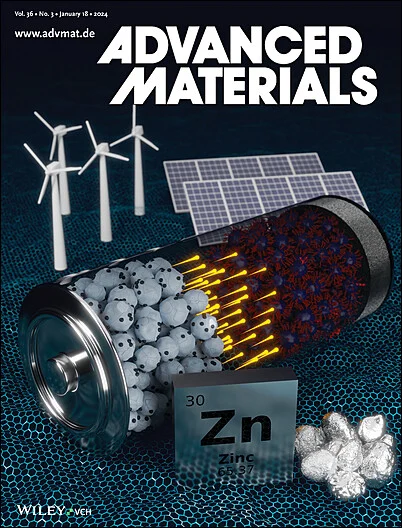连接电子云电位阱实现摩擦纳米发电机超高输出电流。
IF 26.8
1区 材料科学
Q1 CHEMISTRY, MULTIDISCIPLINARY
引用次数: 0
摘要
随着物联网和智能机器人的发展,对分布式柔性传感器网络和便携式电源设备的需求越来越大。摩擦电纳米发电机(TENG)作为一种自供电传感器和微纳米电源,可以将无规则的、无处不在的机械能转化为电能,在人机交互、软机器人、可穿戴医疗等领域有着广阔的应用前景。然而,在teng中实现超高电流密度和耐水性仍然具有挑战性,主要是由于摩擦电层内部的电子未被利用。本文提出将摩擦电材料的电子云势阱(ECPWs)连接起来可以使teng的输出电流大幅增加。通过将还原氧化石墨烯(rGO)的导电网络嵌入乙基纤维素(EC)和聚二甲基硅氧烷(PDMS)的摩擦电层,验证了这一假设。在工作在接触分离模式下的TENG中,基于该模型的TENG显示出创纪录的高电流密度≈3533 mA m-2。此外,这款TENG在高湿度甚至多雨的环境中表现出出色的耐久性。这项工作为制造具有超高输出电流和水阻的teng提供了一种新颖而有前途的策略,极大地扩展了其在许多领域的实际应用。本文章由计算机程序翻译,如有差异,请以英文原文为准。
Linking Electron Cloud Potential Wells to Achieve Ultrahigh Output Current in a Triboelectric Nanogenerator.
With the development of the Internet of Things and intelligent robots, there is an increasing demand for distributed flexible sensor networks and portable power devices. As a self-powered sensor and micro/nano powering supplier, triboelectric nanogenerator (TENG) that can convert the irregular and ubiquitous mechanical energy into electrical energy demonstrates promising applications in human-machine interaction, soft robotics, wearable healthcare, etc. However, achieving ultrahigh current density and water resistance in TENGs remains challenging, mainly due to the non-utilization of the electrons in the interior of triboelectric layers. Herein, it is proposed that linking the electron cloud potential wells (ECPWs) of triboelectric materials can lead to a huge increase in the output current of TENGs. This hypothesis is verified by embedding a conductive network of reduced graphene oxide (rGO) into the triboelectric layers of ethyl cellulose (EC) and polydimethylsiloxane (PDMS). The TENG based on this model demonstrates a record-high current density of ≈3533 mA m-2 among the TENGs working in contact-separation mode. In addition, this TENG shows excellent endurance in high-humidity and even rainy environments. This work provides a novel and promising strategy for fabricating TENGs with ultrahigh output current and water resistance, largely expanding their practical applications in many fields.
求助全文
通过发布文献求助,成功后即可免费获取论文全文。
去求助
来源期刊

Advanced Materials
工程技术-材料科学:综合
CiteScore
43.00
自引率
4.10%
发文量
2182
审稿时长
2 months
期刊介绍:
Advanced Materials, one of the world's most prestigious journals and the foundation of the Advanced portfolio, is the home of choice for best-in-class materials science for more than 30 years. Following this fast-growing and interdisciplinary field, we are considering and publishing the most important discoveries on any and all materials from materials scientists, chemists, physicists, engineers as well as health and life scientists and bringing you the latest results and trends in modern materials-related research every week.
 求助内容:
求助内容: 应助结果提醒方式:
应助结果提醒方式:


